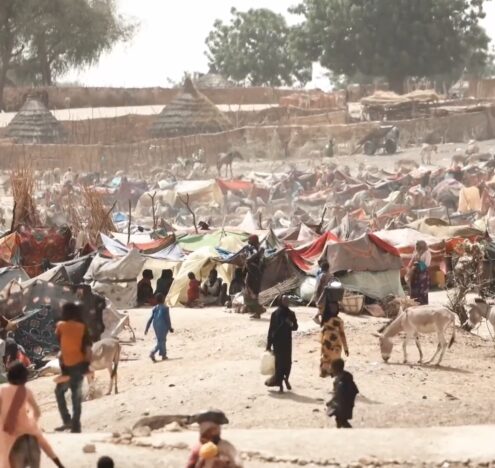In June 2003, I traveled to Baghdad as part of a civilian team of policy analysts who were experts in post-conflict reconstruction. We were the first independent civilian team allowed to visit. In the wake of weeks of hostilities, with the US and coalition forces still in Phase 3 Operations mode, the scene on the ground in Baghdad was anything but calm.
We were tasked with trying to understand what was needed after the fighting stopped. It was clear from our first day on the ground that little thinking had been done about what to do next, but one thing was certain. Immediate efforts to take down Saddam Hussein’s army, labeled De-Ba’athification, had started. This controversial decision by US Ambassador L. Paul Bremmer, the head of the Coalition Provision Authority, to disband Saddam’s army is thought to have led to the ensuing insurgency. I remember hearing our US military escorts express alarm about this decision since they saw that disbanding an army in the wake of an international invasion was a formula for even greater insecurity. The violence in the following weeks — and 11 years of US occupation — proved them right. Things have not improved much in Iraq since the United States invaded it 20 years ago.
Over 200,000 civilians died at the hands of US forces, al-Qaeda militants, and the Islamic State of Iraq and Syria (ISIS) in Iraq. About 4,600 troops and 3,600 contractors lost their lives on the US side. More tragic was that in 2011, when US troops finally withdrew, there was scant evidence of rebuilding. The political divisions that the war exposed in 2003 remain an open wound that pitted Sunni against Shiite Iraqis. It led to the rise of ISIS, which held citizens hostage in cities like Mosul and Falluja for years.
While food was not central to our post-conflict reconstruction project, it should have been. It was clear on the ground that food was in short supply based on what we saw on the brief drives we took through different cities.
During my 2003 visit, I stayed in the Green Zone. Most of my dining was limited to the catered mess at what was once Saddam’s Palace. The palace banquet hall had been transformed and was now managed by a contractor from the United Arab Emirates. Rather than the delicious breakfast foods of Baghdad, such as maklama (a mixture of lamb, eggs, and tomatoes served with freshly baked samoon, a type of bread common in Iraq), our options were fruit loops cereal, bacon and eggs, or peanut butter and white bread. It was hardly a feast of Iraqi delicacies. With the June daytime temperatures soaring to 120 F, our greatest need was for water, so each of us was given a 2-liter bottle. It quickly turned to hot water, more fitting for afternoon tea than for quenching one’s thirst, but it kept us hydrated.
As we traveled around the country, we were given Meals Ready to Eat — another far cry from Iraqi cuisine. However, once we had a rare meal of kebobs after meeting with local officials in towns whose names all became a blur. Fortunately, one of my colleagues brought some energy bars along for the ride. Our schedules were determined by an agenda that did not consider eating to be part of the program. I recall that in Sulaimaniya, our US military escorts wanted us to leave to ensure being on time for the next meeting. This type of abrupt departure from a meal was considered rude. I always felt this contributed to yet another example of “the ugly American.”
While food was not central to our post-conflict reconstruction project, it should have been. It was clear on the ground that food was in short supply based on what we saw on the brief drives we took through different cities. Marketplaces were often quiet. In the north, when we were able to see what was for sale, often there were goods labeled “oil-for-food” commodities, a sign of how what was supposed to be given away as part of humanitarian aid was actually being sold for a profit. As we watched groups of men who had lost their jobs marching in protest over the disbanding of the army, we realized that unemployment would result in many hungry families since there would no longer be money to buy food. As we watched this unfold, we also knew that only trouble could follow without a reconstruction plan that understood the need for security and socioeconomic well-being. And it did.
An Ancient Food Culture
Iraqi cuisine is one of the oldest cuisines in the world and goes back some 10,000 years — to the Sumerians, Akkadians, Babylonians, Assyrians, and ancient Persians. The Fertile Crescent, the land between the Tigris and Euphrates Rivers, is considered the center of modern agrarian life. Ancient Babylon (which eventually became Baghdad), the city of biblical tales and cuneiform recipe tablets, was the Middle East’s culinary capital until the 13th century when the Mongols conquered it in 1258. Much of the Middle Eastern table consumed today originated in Babylon. Iraq was also a trading crossroad where spices from Asia were transferred to the Levant. These are flavors that still dominate the Iraqi kitchen.
Today Iraqi food, like other cuisines, has unique specialties in each region, not unusual for a country as big as the state of California. The cooking style is less spicy than in neighboring countries like Iran, Syria, or Turkey. It is fair to say, however, that the borderless nature of cuisine in the Middle East could be considered an asset when it comes to building trust among different nations. My own experience working with refugees in Turkey is that they found common ground when the conversation among women switched to comparing similar dishes that both cultures prepared but were known by different names. Dolmas, a Middle Eastern staple, used grape leaves in Turkey but chard in Iraq. Falafal, the chickpea fritters consumed throughout the Levant, is another dish without borders.
Iraq’s signature dish is masgouf, a grilled carp that is roasted vertically on a spit over a fire, marinated in herbs and tamarind sauce, and served with pita bread. All along the Tigris River in Baghdad, masgouf restaurants offer locals and visitors a taste of this famous dish. It is a difficult dish to make because it takes a lot of time to prepare. In the United States, the carp, a river fish, is our closest species. However, restaurants in this country use tilapia since that mild white fish is more appealing to our tastebuds. Omar, my Iraqi friend, says that people in the United States often travel to a restaurant in Detroit, Ishtar, to eat this dish.
Eating At Your Own Risk?
Food in Iraq was already a challenge when coalition forces invaded in March 2003. Iraq had always been dependent on imported food. Its main cash export crop, dates, did not provide enough revenue for farmers. Those who relied on locally grown products were also impacted by the war as conflict prevented farmers from planting crops. Climate change in some parts of the country exacerbated growing conditions.
The Oil for Food Program, a sanctions regime managed by the UN after the first Gulf War, offered food rations to Iraq in exchange for its oil. This program not only made it difficult for people to access food, but the rampant corruption in its management undermined the program’s goal of trying to oust Saddam. By 2000, 60% of Iraq’s families relied solely on the food rations from the Oil-for-Food program to meet all household needs as a major humanitarian crisis unfolded.
When my students visited an Iraqi restaurant, they also met Iraq war veterans who sought out these restaurants because the smell of the food and the taste of the meal reminded them of their time deployed in Iraq.
As sectarian violence grew after the March 2003 invasion, Iraqis fled to neighboring countries, especially Turkey, Saudi Arabia, Iran, and Lebanon. Many Iraqis also wound up in the United States. It is this diaspora, the third wave in our history with the region, that endowed us with the benefits of their culinary cultural heritage. Today, in Los Angeles, Detroit, and the Washington, DC metropolitan area, we see evidence of displaced communities in the restaurants that offer immigrants a place to gather and rebuild trust, create new lives, and most importantly, offer others the tastes of their homeland’s best dishes. We are the beneficiaries of Iraq’s unintentional gastrodiplomacy program.
In 2015, when I started teaching classes about food and war, some of my students asked to write about the impact of the Iraq war on our local food scene. When they visited some of our local Iraqi-owned eateries, I knew I would learn about the traditional mix of kebabs, salads, and sweets. But what they found surprised me. When they visited an Iraqi restaurant, they found that in addition to other Iraqi immigrants, they met Iraq war veterans who sought out these restaurants almost daily because the smell of the food and the taste of the meal reminded them of their time deployed in Iraq.
At one restaurant, the Tigris Grill in Fairfax, Virginia (it is no longer owned by an Iraqi), I called the owner to confirm what my students saw. He told me that the presence of former US soldiers surprised him too, but it seemed that after talking to them, he also learned that this connection between food and their wartime service filled an important gap in their transition to civilian life. It may also have been a way of rebuilding trust with a group of people who were once considered the enemy.
Another war veteran, Felicia Campbell, wrote an article in the culinary magazine Saveur about her experiences as a soldier in Iraq. She spoke of the tension between eating with the enemy and her need for delicious Iraqi food. Stationed at Camp Udairi, at the Iraq-Kuwait border, she was limited at the start of the war with only Meals Ready to Eat and two liters of water a day. As she and her fellow soldiers moved further into Iraq, their base near Nineveh soon saw Iraqi entrepreneurs opening businesses that sold fresh grilled chicken and pita. She described a sign on the base that read: “Unauthorized eating establishment: Eat at your own risk. It is against military regulation to intentionally harm your body. Use discretion when consuming unsanctioned food.”
Despite the warning, Campbell proceeded to purchase a $2 dollar plate and devoured a half chicken and fresh pita. She said, “I ate and ate, the flavors of cardamon, coriander, fenugreek, and turmeric, cloves and allspice, pepper and rose striking my palate, many of them for the first time. They were the tastes of what Iraqis call bashr asfar, yellow spice, brought centuries ago from South Asia.” It was this important connection with the local cuisines that opened not only the palate but the minds of many soldiers who found dining with the enemy a time to ponder who was the enemy they were fighting. Campbell went on after the war to study food history and become a travel writer.
Breaking bread together is an important tool for building trust. It was ironic that in Iraq, the local cuisine prepared around military bases for US and coalition forces often had the opposite effect. Soldiers wanted to taste delicious local food but were taught that eating it outside the base could be a trap, a way to lure a person. Sharing food, however, is something that demonstrates our humanity, even during a war. Campbell wrote that years after her service in Iraq, she “still longs to thank [the men] for feeding me. With that simple grilled chicken, they nourished my humanity, so often the first casualty of war.”
A more recent example comes from my friend Omar. Fearing the sectarian violence in Iraq, he finally arrived in Washington, DC, in 2008. He still misses the taste of home. “When you grow up in a country, it is hard to like the taste of another country. Iraqi food is not concerned about the healthy side of the food. It is our soul food. It is also heart-attack food. The Iraqi kabob is 60% fat!” He added that “Kabob is good here. But it will not be 100% like home. The lamb in Iraq is different from other sheep. Grass is different.”
Omar explained that during the Saddam regime, people risked their lives smuggling Iraqi sheep into Saudi Arabia, evidence of the demand for high-quality lamb meat. He also lamented that Iraqi-owned restaurants were declining in the United States and being replaced by those that reflected a more regional approach to Levantine cuisine, offering dishes from Iran, Lebanon, Turkey, and Yemen.
Many Iraqis who live in the Washington area still go to restaurants based not only on their food but on the religious sect of the owner. For example, a Shiia Iraqi will not patronize a Sunni restaurant. As Omar explained, it was just the reality of a post-war society. While he did not provide data to confirm his observation, it seems plausible that the sectarianism that tore apart his country for more than two decades could also manifest itself in the choice of eating establishments.
“War and the memory of war divides Iraq today. Not everyone hated Saddam. So, people often try to avoid talking about politics.” Omar added that after 2006, words triggered violence in Iraq: “Sunnis started blaming Shiia. They were armed with guns. People lost their loved ones. Innocent victims who never carried guns died. As Iraqis, we don’t want to repeat the tragedies of the war.” But dining together to create commonality and trust may eventually get you there in the long run.
Iraq Today
Today, Iraq is a very different place. More than half the population of 42 million was born after 2000. Those born after 2003 did not know life under the brutal regime of Saddam Hussein. The young crowd who lives in Baghdad are more likely to head out to nightclubs than they are to a mosque. YouTube interviews with intrepid travelers feature videos of them eating on Al Rasheed Street in the business district of Baghdad in search of a good breakfast.
Massoud Mostajabi, the Associate Director of the Iraq Initiatives at The Atlantic Council, recently spent two weeks in Erbil and was amazed by the city’s cosmopolitan vibe. “There were sushi bars, fast food restaurants, and international cuisines, with many nightclubs, where the alcohol flowed. I thought I was in Dubai, not Iraq.” Granted, Erbil has always been a crossroads, a city that borders Turkey with a very dynamic Kurdish population. Yet, to hear Massoud describe the variety of eateries was a sign of how far this Iraqi city has developed since 2003.
In the last two decades, a new generation of Iraqis seek to live in peace and find work to support their families. Once again, Iraqis go to the banks of the Tigris River in Baghdad and enjoy the national dish of Iraq, masgouf, not even able to imagine a city that was once cordoned off by barbed wire and patrolled by Humvees every night.
And in Washington, where I can find a microcosm of the regional groups of Iraqis dining each night, I can learn more about the cuisine that eluded me in the early days of the war in 2003. Because we think about food as a source of place, identity, and culture, it is also important to those who have left their homeland to replicate the tastes of home in their newly adopted land. As my friend Omar told me, “When you grow up in one country, it is hard to like the taste of another country. Food is part of your identity.”
I keep telling Omar that it is possible to continue the traditions of Iraq’s historic culinary legacy, no matter where you are, so long as your kitchen is open and you use national foods as a tool to build peace.





















